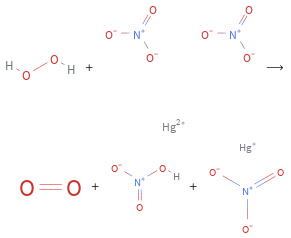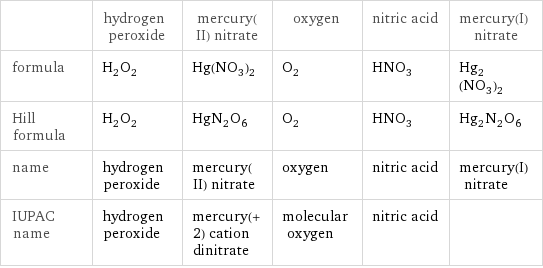Input interpretation

H_2O_2 hydrogen peroxide + Hg(NO_3)_2 mercury(II) nitrate ⟶ O_2 oxygen + HNO_3 nitric acid + Hg_2(NO_3)_2 mercury(I) nitrate
Balanced equation

Balance the chemical equation algebraically: H_2O_2 + Hg(NO_3)_2 ⟶ O_2 + HNO_3 + Hg_2(NO_3)_2 Add stoichiometric coefficients, c_i, to the reactants and products: c_1 H_2O_2 + c_2 Hg(NO_3)_2 ⟶ c_3 O_2 + c_4 HNO_3 + c_5 Hg_2(NO_3)_2 Set the number of atoms in the reactants equal to the number of atoms in the products for H, O, Hg and N: H: | 2 c_1 = c_4 O: | 2 c_1 + 6 c_2 = 2 c_3 + 3 c_4 + 3 c_5 Hg: | c_2 = c_5 N: | 2 c_2 = c_4 + c_5 Since the coefficients are relative quantities and underdetermined, choose a coefficient to set arbitrarily. To keep the coefficients small, the arbitrary value is ordinarily one. For instance, set c_1 = 1 and solve the system of equations for the remaining coefficients: c_1 = 1 c_2 = 2 c_3 = 1 c_4 = 2 c_5 = 2 Substitute the coefficients into the chemical reaction to obtain the balanced equation: Answer: | | H_2O_2 + 2 Hg(NO_3)_2 ⟶ O_2 + 2 HNO_3 + 2 Hg_2(NO_3)_2
Structures

+ ⟶ + +
Names

hydrogen peroxide + mercury(II) nitrate ⟶ oxygen + nitric acid + mercury(I) nitrate
Equilibrium constant
![Construct the equilibrium constant, K, expression for: H_2O_2 + Hg(NO_3)_2 ⟶ O_2 + HNO_3 + Hg_2(NO_3)_2 Plan: • Balance the chemical equation. • Determine the stoichiometric numbers. • Assemble the activity expression for each chemical species. • Use the activity expressions to build the equilibrium constant expression. Write the balanced chemical equation: H_2O_2 + 2 Hg(NO_3)_2 ⟶ O_2 + 2 HNO_3 + 2 Hg_2(NO_3)_2 Assign stoichiometric numbers, ν_i, using the stoichiometric coefficients, c_i, from the balanced chemical equation in the following manner: ν_i = -c_i for reactants and ν_i = c_i for products: chemical species | c_i | ν_i H_2O_2 | 1 | -1 Hg(NO_3)_2 | 2 | -2 O_2 | 1 | 1 HNO_3 | 2 | 2 Hg_2(NO_3)_2 | 2 | 2 Assemble the activity expressions accounting for the state of matter and ν_i: chemical species | c_i | ν_i | activity expression H_2O_2 | 1 | -1 | ([H2O2])^(-1) Hg(NO_3)_2 | 2 | -2 | ([Hg(NO3)2])^(-2) O_2 | 1 | 1 | [O2] HNO_3 | 2 | 2 | ([HNO3])^2 Hg_2(NO_3)_2 | 2 | 2 | ([Hg2(NO3)2])^2 The equilibrium constant symbol in the concentration basis is: K_c Mulitply the activity expressions to arrive at the K_c expression: Answer: | | K_c = ([H2O2])^(-1) ([Hg(NO3)2])^(-2) [O2] ([HNO3])^2 ([Hg2(NO3)2])^2 = ([O2] ([HNO3])^2 ([Hg2(NO3)2])^2)/([H2O2] ([Hg(NO3)2])^2)](../image_source/2c85e717abe122740916547a2c2a4dc8.png)
Construct the equilibrium constant, K, expression for: H_2O_2 + Hg(NO_3)_2 ⟶ O_2 + HNO_3 + Hg_2(NO_3)_2 Plan: • Balance the chemical equation. • Determine the stoichiometric numbers. • Assemble the activity expression for each chemical species. • Use the activity expressions to build the equilibrium constant expression. Write the balanced chemical equation: H_2O_2 + 2 Hg(NO_3)_2 ⟶ O_2 + 2 HNO_3 + 2 Hg_2(NO_3)_2 Assign stoichiometric numbers, ν_i, using the stoichiometric coefficients, c_i, from the balanced chemical equation in the following manner: ν_i = -c_i for reactants and ν_i = c_i for products: chemical species | c_i | ν_i H_2O_2 | 1 | -1 Hg(NO_3)_2 | 2 | -2 O_2 | 1 | 1 HNO_3 | 2 | 2 Hg_2(NO_3)_2 | 2 | 2 Assemble the activity expressions accounting for the state of matter and ν_i: chemical species | c_i | ν_i | activity expression H_2O_2 | 1 | -1 | ([H2O2])^(-1) Hg(NO_3)_2 | 2 | -2 | ([Hg(NO3)2])^(-2) O_2 | 1 | 1 | [O2] HNO_3 | 2 | 2 | ([HNO3])^2 Hg_2(NO_3)_2 | 2 | 2 | ([Hg2(NO3)2])^2 The equilibrium constant symbol in the concentration basis is: K_c Mulitply the activity expressions to arrive at the K_c expression: Answer: | | K_c = ([H2O2])^(-1) ([Hg(NO3)2])^(-2) [O2] ([HNO3])^2 ([Hg2(NO3)2])^2 = ([O2] ([HNO3])^2 ([Hg2(NO3)2])^2)/([H2O2] ([Hg(NO3)2])^2)
Rate of reaction
![Construct the rate of reaction expression for: H_2O_2 + Hg(NO_3)_2 ⟶ O_2 + HNO_3 + Hg_2(NO_3)_2 Plan: • Balance the chemical equation. • Determine the stoichiometric numbers. • Assemble the rate term for each chemical species. • Write the rate of reaction expression. Write the balanced chemical equation: H_2O_2 + 2 Hg(NO_3)_2 ⟶ O_2 + 2 HNO_3 + 2 Hg_2(NO_3)_2 Assign stoichiometric numbers, ν_i, using the stoichiometric coefficients, c_i, from the balanced chemical equation in the following manner: ν_i = -c_i for reactants and ν_i = c_i for products: chemical species | c_i | ν_i H_2O_2 | 1 | -1 Hg(NO_3)_2 | 2 | -2 O_2 | 1 | 1 HNO_3 | 2 | 2 Hg_2(NO_3)_2 | 2 | 2 The rate term for each chemical species, B_i, is 1/ν_i(Δ[B_i])/(Δt) where [B_i] is the amount concentration and t is time: chemical species | c_i | ν_i | rate term H_2O_2 | 1 | -1 | -(Δ[H2O2])/(Δt) Hg(NO_3)_2 | 2 | -2 | -1/2 (Δ[Hg(NO3)2])/(Δt) O_2 | 1 | 1 | (Δ[O2])/(Δt) HNO_3 | 2 | 2 | 1/2 (Δ[HNO3])/(Δt) Hg_2(NO_3)_2 | 2 | 2 | 1/2 (Δ[Hg2(NO3)2])/(Δt) (for infinitesimal rate of change, replace Δ with d) Set the rate terms equal to each other to arrive at the rate expression: Answer: | | rate = -(Δ[H2O2])/(Δt) = -1/2 (Δ[Hg(NO3)2])/(Δt) = (Δ[O2])/(Δt) = 1/2 (Δ[HNO3])/(Δt) = 1/2 (Δ[Hg2(NO3)2])/(Δt) (assuming constant volume and no accumulation of intermediates or side products)](../image_source/c3ce982a9602f3052a30c64bce71cc42.png)
Construct the rate of reaction expression for: H_2O_2 + Hg(NO_3)_2 ⟶ O_2 + HNO_3 + Hg_2(NO_3)_2 Plan: • Balance the chemical equation. • Determine the stoichiometric numbers. • Assemble the rate term for each chemical species. • Write the rate of reaction expression. Write the balanced chemical equation: H_2O_2 + 2 Hg(NO_3)_2 ⟶ O_2 + 2 HNO_3 + 2 Hg_2(NO_3)_2 Assign stoichiometric numbers, ν_i, using the stoichiometric coefficients, c_i, from the balanced chemical equation in the following manner: ν_i = -c_i for reactants and ν_i = c_i for products: chemical species | c_i | ν_i H_2O_2 | 1 | -1 Hg(NO_3)_2 | 2 | -2 O_2 | 1 | 1 HNO_3 | 2 | 2 Hg_2(NO_3)_2 | 2 | 2 The rate term for each chemical species, B_i, is 1/ν_i(Δ[B_i])/(Δt) where [B_i] is the amount concentration and t is time: chemical species | c_i | ν_i | rate term H_2O_2 | 1 | -1 | -(Δ[H2O2])/(Δt) Hg(NO_3)_2 | 2 | -2 | -1/2 (Δ[Hg(NO3)2])/(Δt) O_2 | 1 | 1 | (Δ[O2])/(Δt) HNO_3 | 2 | 2 | 1/2 (Δ[HNO3])/(Δt) Hg_2(NO_3)_2 | 2 | 2 | 1/2 (Δ[Hg2(NO3)2])/(Δt) (for infinitesimal rate of change, replace Δ with d) Set the rate terms equal to each other to arrive at the rate expression: Answer: | | rate = -(Δ[H2O2])/(Δt) = -1/2 (Δ[Hg(NO3)2])/(Δt) = (Δ[O2])/(Δt) = 1/2 (Δ[HNO3])/(Δt) = 1/2 (Δ[Hg2(NO3)2])/(Δt) (assuming constant volume and no accumulation of intermediates or side products)
Chemical names and formulas

| hydrogen peroxide | mercury(II) nitrate | oxygen | nitric acid | mercury(I) nitrate formula | H_2O_2 | Hg(NO_3)_2 | O_2 | HNO_3 | Hg_2(NO_3)_2 Hill formula | H_2O_2 | HgN_2O_6 | O_2 | HNO_3 | Hg_2N_2O_6 name | hydrogen peroxide | mercury(II) nitrate | oxygen | nitric acid | mercury(I) nitrate IUPAC name | hydrogen peroxide | mercury(+2) cation dinitrate | molecular oxygen | nitric acid |
Substance properties

| hydrogen peroxide | mercury(II) nitrate | oxygen | nitric acid | mercury(I) nitrate molar mass | 34.014 g/mol | 324.6 g/mol | 31.998 g/mol | 63.012 g/mol | 262.596 g/mol phase | liquid (at STP) | solid (at STP) | gas (at STP) | liquid (at STP) | melting point | -0.43 °C | 79 °C | -218 °C | -41.6 °C | boiling point | 150.2 °C | | -183 °C | 83 °C | density | 1.44 g/cm^3 | 4.3 g/cm^3 | 0.001429 g/cm^3 (at 0 °C) | 1.5129 g/cm^3 | solubility in water | miscible | soluble | | miscible | slightly soluble surface tension | 0.0804 N/m | | 0.01347 N/m | | dynamic viscosity | 0.001249 Pa s (at 20 °C) | | 2.055×10^-5 Pa s (at 25 °C) | 7.6×10^-4 Pa s (at 25 °C) | odor | | | odorless | |
Units
